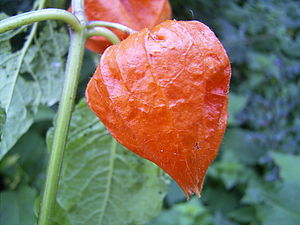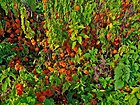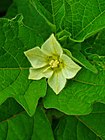Note: This is a project under development. The articles on this wiki are just being initiated and broadly incomplete. You can Help creating new pages.
Difference between revisions of "Physalis alkekengi - Bladder cherry"
(→External Links) |
(→Photo Gallery) |
||
| (22 intermediate revisions by 2 users not shown) | |||
| Line 1: | Line 1: | ||
[[File:PhysalisAlkekengi-balloon.jpg|thumb|right|''Physalis alkekengi'']] | [[File:PhysalisAlkekengi-balloon.jpg|thumb|right|''Physalis alkekengi'']] | ||
| − | + | '''Physalis alkekengi''' is easily identifiable by the large, bright orange to red papery covering over its fruit, which resembles paper lanterns. | |
| − | '''Physalis alkekengi''' | ||
| − | |||
==Uses== | ==Uses== | ||
| − | {{Uses| | + | {{Uses|Abortion}}, {{Uses|Gravel}}, {{Uses|Malaise}}, {{Uses|Malaria}}, {{Uses|Skin inflammations}}, {{Uses|Kidney}}, {{Uses|Bladder disorders}}, {{Uses|Common Cold}}, {{Uses|Gout}}, {{Uses|Wounds}}, {{Uses|Cough}}<ref name="Karnataka Medicinal Plants"/>. |
==Parts Used== | ==Parts Used== | ||
| − | {{Parts Used|Roots}}, {{Parts Used|Leaves}}, {{Parts Used|Fruits}}. | + | {{Parts Used|Roots}}, {{Parts Used|Leaves}}, {{Parts Used|Fruits}}<ref name="Karnataka Medicinal Plants"/>. |
==Chemical Composition== | ==Chemical Composition== | ||
| − | Like a number of other species in the genus Physalis, it contains a wide variety of physalins. When isolated from the plant, these have antibacterial and leishmanicidal activities in vitro. | + | Like a number of other species in the genus Physalis, it contains a wide variety of physalins. When isolated from the plant, these have antibacterial and leishmanicidal activities in vitro.<ref name="chemical composition"/> |
==Common names== | ==Common names== | ||
| − | {{Common names|kn=|ml=Akkarakaaram|sa= | + | {{Common names|kn=ದೊಡ್ಡ ಬುಡ್ಡೆ ಗಿಡ Dodda budde gida, Tankari|ml=Akkarakaaram|sa=Akarkara, Avautha|ta=Periya-takkali|gu=Moti popti|te=Kuppanti|hi=Akarkara, Tankari, Tipari|en=Pellitory|mr=Popti|te=Winter cherry}}<ref name="Common names"/> |
==Properties== | ==Properties== | ||
| Line 32: | Line 30: | ||
==Habit== | ==Habit== | ||
| − | {{Habit| | + | {{Habit|Herb}} |
==Identification== | ==Identification== | ||
| Line 39: | Line 37: | ||
===Flower=== | ===Flower=== | ||
| − | {{Flower|Unisexual|15–20 mm (0.6–0.8 in.) wide| | + | {{Flower|Unisexual|15–20 mm (0.6–0.8 in.) wide|Yellowish white|Stamens 5|Regular (actinomorphic), fused, wheel-shaped, 5-lobed, underside hairy. Flowering from July to November}} |
===Fruit=== | ===Fruit=== | ||
| − | {{Fruit| | + | {{Fruit|Spherical|15 mm (0.6 in.) long berry|||Many|Fruiting from July to November}} |
===Other features=== | ===Other features=== | ||
==List of Ayurvedic medicine in which the herb is used== | ==List of Ayurvedic medicine in which the herb is used== | ||
| − | |||
==Where to get the saplings== | ==Where to get the saplings== | ||
| Line 54: | Line 51: | ||
==How to plant/cultivate== | ==How to plant/cultivate== | ||
| − | + | Seed - sow March/April in a greenhouse only just covering the seed. Germination usually takes place quickly and freely. <ref name="Cultivation details"/> | |
==Commonly seen growing in areas== | ==Commonly seen growing in areas== | ||
| − | {{Commonly seen| | + | {{Commonly seen|Wasteland}}, {{Commonly seen|Gardens}}, {{Commonly seen|Ornamental}}. |
==Photo Gallery== | ==Photo Gallery== | ||
<gallery class="left" caption="" widths="140px" heights="140px"> | <gallery class="left" caption="" widths="140px" heights="140px"> | ||
File:Physalis alkekengi 006.JPG | File:Physalis alkekengi 006.JPG | ||
| − | |||
File:Physalis alkekengi 005.JPG | File:Physalis alkekengi 005.JPG | ||
| − | File:Physalis alkekengi | + | File:Physalis alkekengi franchetii 0.4 R.jpg|Leaves |
| − | |||
File:Physalis alkekengi Bladder Cherry ონტკოფა.JPG | File:Physalis alkekengi Bladder Cherry ონტკოფა.JPG | ||
| + | File:Phal5 001 php.jpg|Seeds | ||
| + | File:Physalis alkekengi 002.JPG|Flower | ||
</gallery> | </gallery> | ||
| Line 72: | Line 69: | ||
<references> | <references> | ||
| − | <ref name="chemical composition">[https://en.wikipedia.org/wiki/Physalis_alkekengi | + | <ref name="chemical composition">[https://en.wikipedia.org/wiki/Physalis_alkekengi Chemical constituents]</ref> |
| − | <ref name="Leaf">[https://www.bimbima.com/ayurveda/medicinal-use-of-akarkara-spilanthes-acmella/1383/ "Plant | + | <ref name="Leaf">[https://www.bimbima.com/ayurveda/medicinal-use-of-akarkara-spilanthes-acmella/1383/ Plant Description]</ref> |
| + | <ref name="Cultivation details">[https://pfaf.org/user/Plant.aspx?LatinName=Physalis+alkekengi Cultivation details]</ref> | ||
| + | <ref name="Common names">[https://sites.google.com/site/indiannamesofplants/via-species/p/physalis-peruviana Common names]</ref> | ||
| + | <ref name="Karnataka Medicinal Plants">”Karnataka Medicinal Plants Volume-3” by Dr.M. R. Gurudeva, Page No.587, Published by Divyachandra Prakashana, #6/7, Kaalika Soudha, Balepete cross, Bengaluru</ref> | ||
</references> | </references> | ||
| Line 84: | Line 84: | ||
[[Category:Herbs]] | [[Category:Herbs]] | ||
| − | [[Category: | + | [[Category:Solanaceae]] |
| − | |||
Latest revision as of 13:58, 10 September 2023
Physalis alkekengi is easily identifiable by the large, bright orange to red papery covering over its fruit, which resembles paper lanterns.
Contents
- 1 Uses
- 2 Parts Used
- 3 Chemical Composition
- 4 Common names
- 5 Properties
- 6 Habit
- 7 Identification
- 8 List of Ayurvedic medicine in which the herb is used
- 9 Where to get the saplings
- 10 Mode of Propagation
- 11 How to plant/cultivate
- 12 Commonly seen growing in areas
- 13 Photo Gallery
- 14 References
- 15 External Links
Uses
Abortion, Gravel, Malaise, Malaria, Skin inflammations, Kidney, Bladder disorders, Common Cold, Gout, Wounds, Cough[1].
Parts Used
Chemical Composition
Like a number of other species in the genus Physalis, it contains a wide variety of physalins. When isolated from the plant, these have antibacterial and leishmanicidal activities in vitro.[2]
Common names
| Language | Common name |
|---|---|
| Kannada | ದೊಡ್ಡ ಬುಡ್ಡೆ ಗಿಡ Dodda budde gida, Tankari |
| Hindi | Akarkara, Tankari, Tipari |
| Malayalam | Akkarakaaram |
| Tamil | Periya-takkali |
| Telugu | Winter cherry |
| Marathi | Popti |
| Gujarathi | Moti popti |
| Punjabi | NA |
| Kashmiri | NA |
| Sanskrit | Akarkara, Avautha |
| English | Pellitory |
Properties
Reference: Dravya - Substance, Rasa - Taste, Guna - Qualities, Veerya - Potency, Vipaka - Post-digesion effect, Karma - Pharmacological activity, Prabhava - Therepeutics.
Dravya
Rasa
Guna
Veerya
Vipaka
Karma
Prabhava
Habit
Identification
Leaf
| Kind | Shape | Feature |
|---|---|---|
| Smooth | Alternate, Pinnate | Alternate or opposite, stalked. Leaf blade widely ovate, usually blunt-based, with entire margins–sparsely large-toothed, sparsely short-haired |
Flower
| Type | Size | Color and composition | Stamen | More information |
|---|---|---|---|---|
| Unisexual | 15–20 mm (0.6–0.8 in.) wide | Yellowish white | Stamens 5 | Regular (actinomorphic), fused, wheel-shaped, 5-lobed, underside hairy. Flowering from July to November |
Fruit
| Type | Size | Mass | Appearance | Seeds | More information |
|---|---|---|---|---|---|
| Spherical | 15 mm (0.6 in.) long berry | Many | Fruiting from July to November |
Other features
List of Ayurvedic medicine in which the herb is used
Where to get the saplings
Mode of Propagation
How to plant/cultivate
Seed - sow March/April in a greenhouse only just covering the seed. Germination usually takes place quickly and freely. [5]
Commonly seen growing in areas
Wasteland, Gardens, Ornamental.
Photo Gallery
References
- ↑ 1.0 1.1 ”Karnataka Medicinal Plants Volume-3” by Dr.M. R. Gurudeva, Page No.587, Published by Divyachandra Prakashana, #6/7, Kaalika Soudha, Balepete cross, Bengaluru
- ↑ Chemical constituents
- ↑ Common names
- ↑ Plant Description
- ↑ Cultivation details
External Links
- Pages using duplicate arguments in template calls
- Ayurvedic Herbs known to be helpful to treat Abortion
- Ayurvedic Herbs known to be helpful to treat Gravel
- Ayurvedic Herbs known to be helpful to treat Malaise
- Ayurvedic Herbs known to be helpful to treat Malaria
- Ayurvedic Herbs known to be helpful to treat Skin inflammations
- Ayurvedic Herbs known to be helpful to treat Kidney
- Ayurvedic Herbs known to be helpful to treat Bladder disorders
- Ayurvedic Herbs known to be helpful to treat Common Cold
- Ayurvedic Herbs known to be helpful to treat Gout
- Ayurvedic Herbs known to be helpful to treat Wounds
- Ayurvedic Herbs known to be helpful to treat Cough
- Herbs with Roots used in medicine
- Herbs with Leaves used in medicine
- Herbs with Fruits used in medicine
- Herbs with common name in Kannada
- Herbs with common name in Hindi
- Herbs with common name in Malayalam
- Herbs with common name in Tamil
- Herbs with common name in Telugu
- Herbs with common name in Marathi
- Herbs with common name in Gujarathi
- Herbs with common name in Sanskrit
- Herbs with common name in English
- Habit - Herb
- Index of Plants which can be propagated by Seeds
- Index of Plants which can be propagated by Cuttings
- Herbs that are commonly seen in the region of Wasteland
- Herbs that are commonly seen in the region of Gardens
- Herbs that are commonly seen in the region of Ornamental
- Herbs
- Solanaceae






